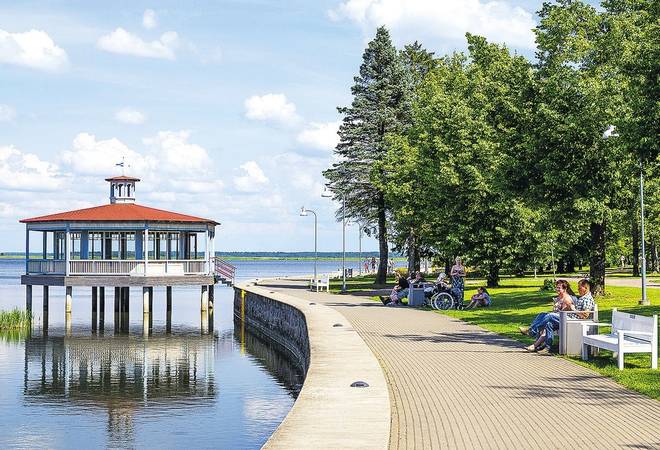(Translation by Google. Edited by Estonia108)
Health resort Haapsalu
Estonia’s undiscovered treasures
The seaside resort of Haapsalu on the Estonian west coast was once a popular summer destination for the Russian aristocracy. Today, the town with its brightly painted wooden houses has one thing in particular: “Bullerbü” charm (popular TV programme for children) – there is a reason for that.

The kilometre-long promenade is very pleasant to stroll along. There is a pretty lake pavilion in the water. Photo: Visit Estonia
By Cornelia Lohs
The hissing and whistling of a departing steam locomotive breaks the silence on the lonely platform. Discarded trains from the Soviet era stand on the grassy tracks, where the rust gnaws. The last train to Tallinn left the station long ago. That was in 1995. Today the site is a museum and the sounds come from loudspeakers. It is thanks to the German-Baltic doctor Carl Abraham Hunnius (1797-1852) that there was ever a station. He, an ancestor of the German musician Herbert Grönemeyer, discovered the healing properties of the Haapsalu sea mud in 1825, opened a healing mud sanatorium and within a few years turned the town into a fashionable health resort.
After Tsar Alexander II first arrived in 1852 with his wife and four sons, the place became a summer hotspot for the Russian nobility and the St. Petersburg rich and beautiful. Members of the tsar family came to the pretty Baltic Sea town until the early 20th century. With the support of Tsar Nikolaus, the magnificent raspberry-red station building was built between 1905 and 1907 with a pavilion especially for the tsar family and a 216-meter-long covered platform, at that time the longest in Europe. The measure corresponded to the length of the Tsar’s private train. Everything should fit when Tsar Nicholas and his family drove into the new train station.
Meanwhile, he preferred to spend the warm season in his summer residence in the Crimea and never saw the train station, let alone used the direct connection St. Petersburg-Haapsalu with his train, which has now existed. The last member of the tsar family who stayed in Haapsalu was Jelisaweta Fyodorovna, a sister-in-law of the tsar. After Estonia was occupied by the Soviet Union in 1944, it declared the place a military exclusion zone. From then on, cures and holidays were only permitted to high-ranking party members and members of the Supreme Soviet and their families.
The richly decorated Kursaal building on the beach promenade is reminiscent of the splendor of days gone by. Art Nouveau villas in the confectioner’s style are lined up along the kilometer-long promenade, a pretty lake pavilion stands in the water, and a modern polar bear statue sits enthroned on a tiny islet. The small section of the beach on the promenade bears the exotic name of Africa – it owes its name to the figures of wild animals that once stood here, but were made into firewood by Soviet soldiers during the war.
The cultural gem of the promenade is a stone bench with notes, with a portrait of Tchaikovsky in the backrest. The Russian composer spent the summer of 1867 in Haapsalu, wrote his opera “Wojewode” there and immortalized the place in the piano cycle “Souvenir de Hapsal”.
The district town, which today has 10,000 inhabitants, boasts two other celebrities. The birthplace of Hedwig Büll is located at 5 Kooli Strasse. As a missionary, she helped save thousands of Armenian orphans during the Armenian genocide in 1915/16 and later set up a refugee camp for the survivors of the genocide in Aleppo, Syria. Büll spent her last years in a nursing home for missionaries in Waldwimmersbach near Heidelberg, Germany, where she died in 1981. Today the house houses “Ilons Wunderland”. The children’s book illustrator Ilon Wikland, who became known for her drawings in Astrid Lindgren’s books, grew up in Haapsalu. Her childhood memories are said to have inspired Wikland when she illustrated the Bullerbü books, because some of the old wooden houses in Haapsalu look like they came straight from Lindgren’s books. The best view of “Bullerbü” is from the medieval bishop’s castle in which the “White Woman” is haunted….
Source: https://www.rnz.de/ratgeber/reise_artikel,-kurort-haapsalu-estlands-unentdeckte-schaetze-_arid,506584.html

